Analysis: Analysis Case

Function
Define an Analysis Case which is required to perform an analysis. Only one analysis can be defined in a single Analysis Case. In one model file, various Analysis Cases can be defined, and each case can have its own mesh, boundary conditions, and loads.
Types of Cases:
Stress-seepage semi-coupled*
Call
Analysis > Analysis Case
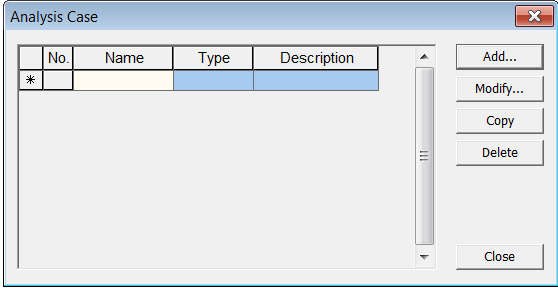
<Analysis Case>
Add
Enter new or additional Analysis Case
Modify
Modify
existing Analysis Case
Copy
Copy existing Analysis Case.
Delete
Delete existing Analysis Case.
Assign boundary conditions, and load sets to be used in the Analysis Case. The data can be activated/deactivated per set by dragging them into the appropriate
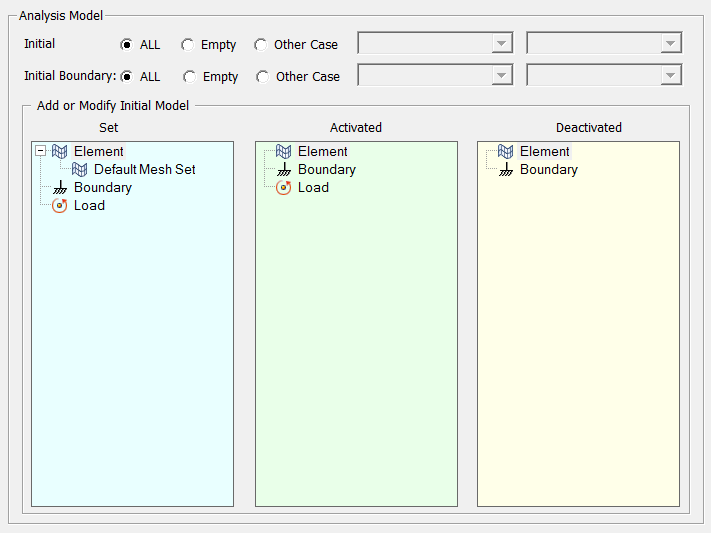
<Analysis Model>
Initial Element / Boundary
Determine
the initial condition of Mesh / BC Sets in the Analysis Case.
All
All Mesh / BC Sets will be used in the analysis.
Empty
No Mesh / BC Sets will be used initially in the analysis. Addition of Mesh / BC Sets should be done in Add or Modify Initial Model
Other Case
The same Mesh / BC Sets from other Analysis Case
will be used.
Add or Modify Initial Model
Select
data sets to be included in the Analysis Case.
Set Tree
The list of all the predefined Mesh, Boundary, and Load Sets is displayed. Although the list appears similar to the Works Tree, its displaying method is very different, and the user must use caution while using it. In the list, all sub-set relationships are ignored and all Mesh Sets are treated independently. Therefore, by dragging only the mother Mesh Set, its subsets will not be assigned in the Analysis Case.
Activated
It contains data sets which are activated in the model. A data set can be registered in Activated Data by dragging it from Set Data to Activated Data or selecting "Activate" from the Context Menu. It is not necessary to activate a data set which is already assigned in Initial Element / Boundary.
Deactivated
It contains data sets which are deactivated among the assigned data set in the Initial Element / Boundary.
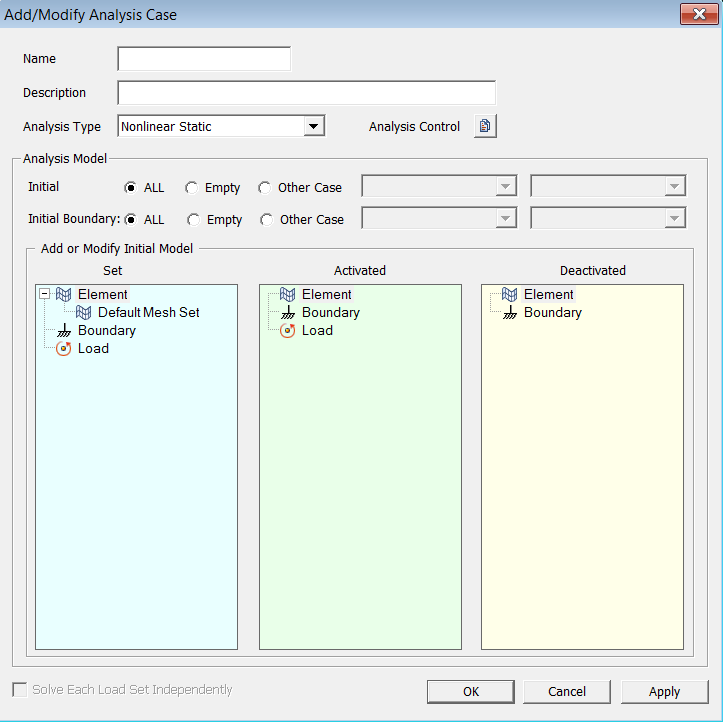
<Add/Modify Analysis Case>
Name
Enter
the name of new Analysis Case. This name is applied to its result file.
Description
Enter a description about the Analysis Case.
Analysis Type
Select an analysis type. GTS includes 9 types of analysis.
Equivalent Linear (Dynamic)
Solve Each Load Set Independently (Linear Static Analysis only)
This option is only available for Linear Static Analysis.
Each Load Set can be treated as an independent load case by selection. Solve Each Load Set as Independently Load Case. For example, when there are 3 inactive Load Sets, if this option is not selected, the 3 sets will be combined and treated as one set/load. When this option is selected, each Load Set will be calculated independently as a single case.
Linear Static Analysis cases can perform Static Analysis, General Foundation Stability Analysis, and Nonlinear Static Analysis on tunnel structures.
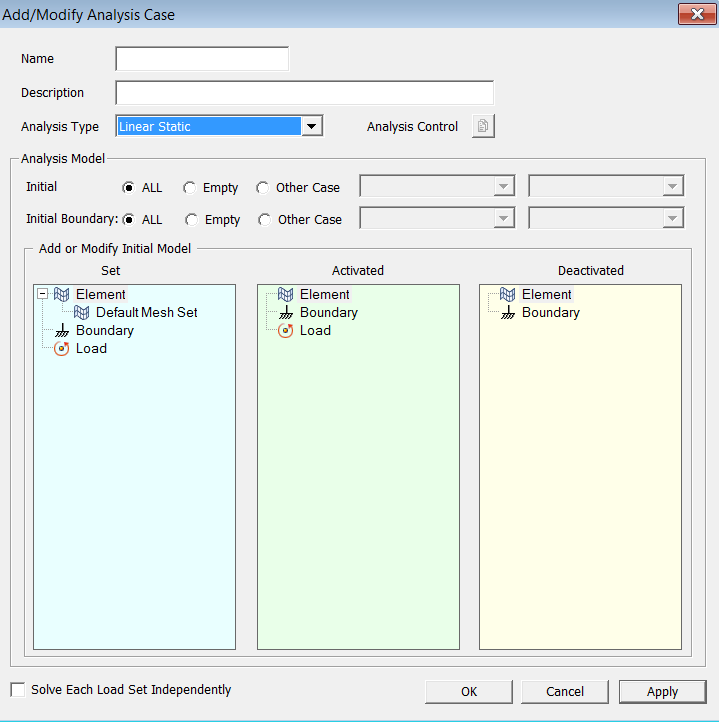
<Add/Modify Analysis Case-Linear Static>
Solve Each Load Set Independently
In Linear Static Analysis, each Load Set can be treated as an independent load case by selection. Solve Each Load Set as Independently Load Case. For example, when there are 3 inactive Load Sets, if this option is not selected, the 3 sets will be combined and treated as one set/load. When this option is selected, each Load Set will be calculated independently as a single case.
Specifies the model data sets for analysis.
Analysis Type - Nonlinear Static
Analysis Case for Nonlinear Analysis can be specified. In this command, general model data and analysis options will be defined.
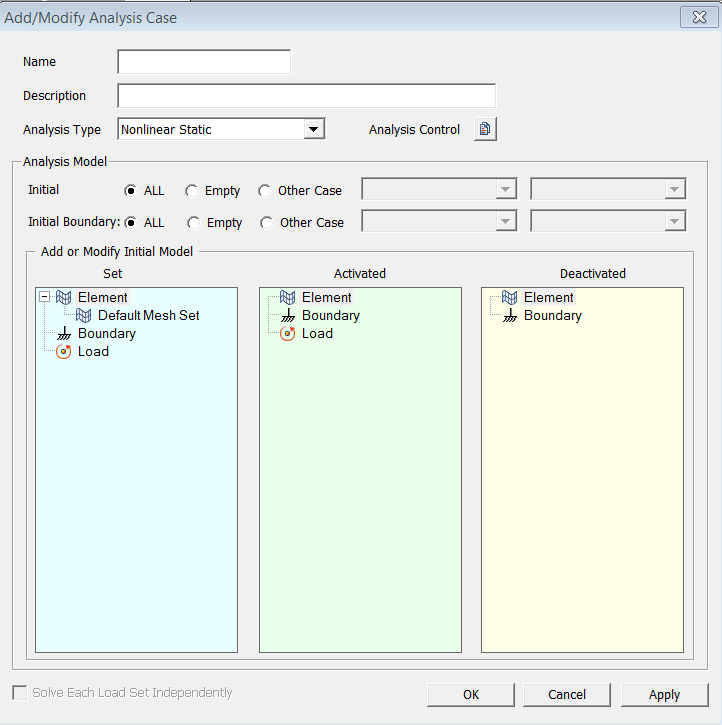
<Add/Modify Analysis Case-Nonlinear Static>
Specifies the model data sets for analysis.
Click  button to define detail options of Analysis
Control for Nonlinear Static.
button to define detail options of Analysis
Control for Nonlinear Static.
Analysis Type - Construction Stage
Analysis Case for Construction Stage Analysis can be specified. In this command, analysis model data and Analysis Control will be defined.
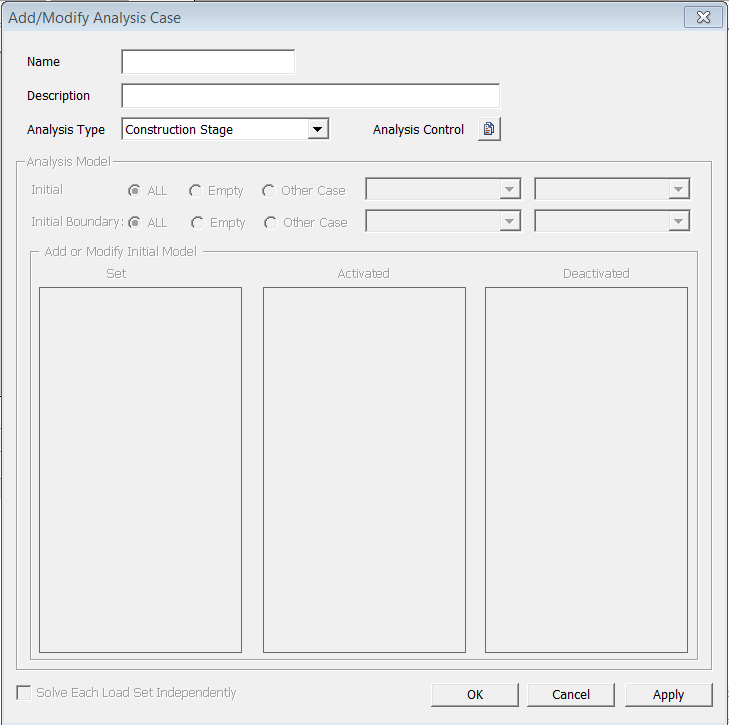
<Add/Modify Analysis Case-Construction Stage>
Specifies the model data sets for analysis.
Click  button to define detail options of Analysis
Control for Construction Stage.
button to define detail options of Analysis
Control for Construction Stage.
Analysis Type - Eigenvalue
Analysis Case for Eigenvalue Analysis can be specified. In this command, analysis model data and Analysis Control will be defined.
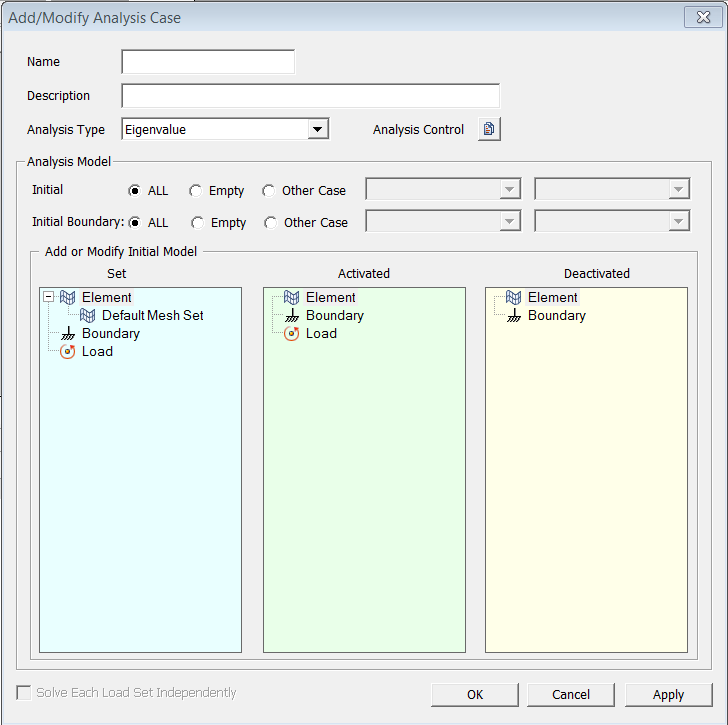
<Add/Modify Analysis Case-Eigenvalue>
Specify model data sets for Eigenvalue Analysis. The data can be activated/deactivated per set by dragging them into the appropriate
Click  button
to define detail options of Analysis Control
for Eigenvalue.
button
to define detail options of Analysis Control
for Eigenvalue.
Analysis Type - Response Spectrum
Analysis Case for Response Spectrum Analysis can be specified. In this command, general model data and analysis options will be defined.
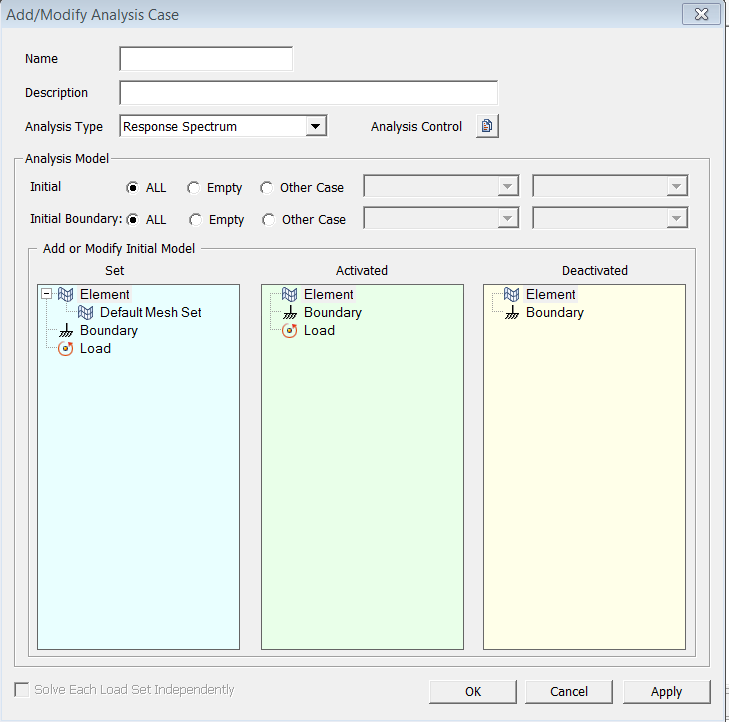
<Add/Modify Analysis Case-Response Spectrum>
Specify model data sets for Response Spectrum Analysis. The data can be activated/deactivated per set by dragging them into the appropriate
Click  button to define detail options of Analysis
Control for Response Spectrum.
button to define detail options of Analysis
Control for Response Spectrum.
Analysis Type - Time History
Analysis Case for Time History Analysis can be specified. In this command, analysis model data and Analysis Control will be defined.
..png)
<Add/Modify Analysis Case-Time History>
Specify model data sets for Time History Analysis. The data can be activated/deactivated per set by dragging them into the appropriate
Click  button
to define detail options of Analysis Control
for Time History.
button
to define detail options of Analysis Control
for Time History.
Analysis Type - Seepage-Steady State
Analysis Case for Seepage -Steady state flow can be specified. In this command, Analysis Model data and Analysis Control will be defined.
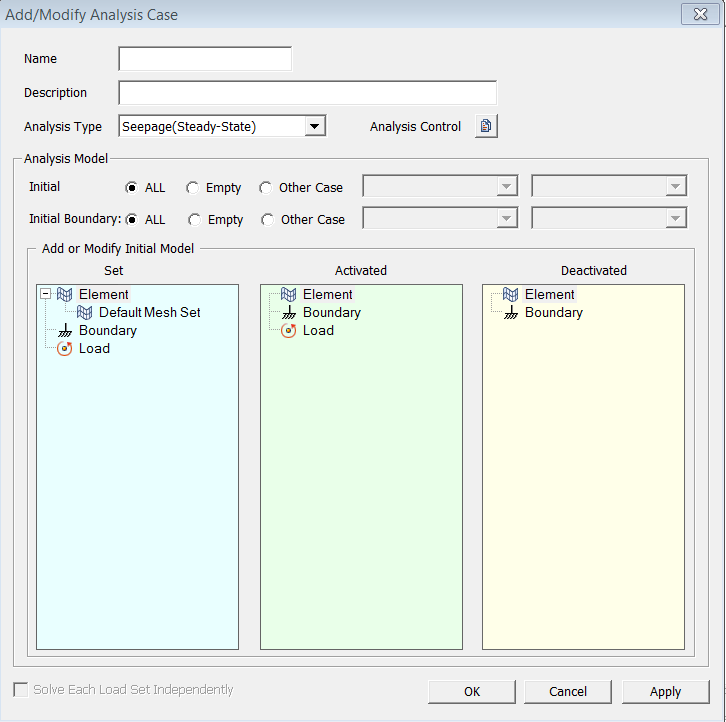
<Add/Modify Analysis Case-Seepage (Steady-State)>
Specify model data sets for Seepage Flow Analysis. The data can be activated/deactivated per set by dragging them into the appropriate menu.
Click  button
to define detail options of Analysis
Control for Seepage-Steady State.
button
to define detail options of Analysis
Control for Seepage-Steady State.
Analysis Type - Seepage-Transient
Analysis Case for Transient Seepage flow analysis can be specified. In this command, Analysis Model data and Analysis Control will be defined.
..png)
<Add/Modify Analysis Case-Seepage (Transient)>
Specify model data sets for Transient Seepage Analysis. The data can be activated/deactivated per set by dragging them into the appropriate menu.
Click  button to define detail options of Analysis
Control for Seepage-Transient Analysis.
button to define detail options of Analysis
Control for Seepage-Transient Analysis.
Analysis Case for Consolidation analysis can be specified. In this command, Analysis Model data and Analysis Control will be defined.
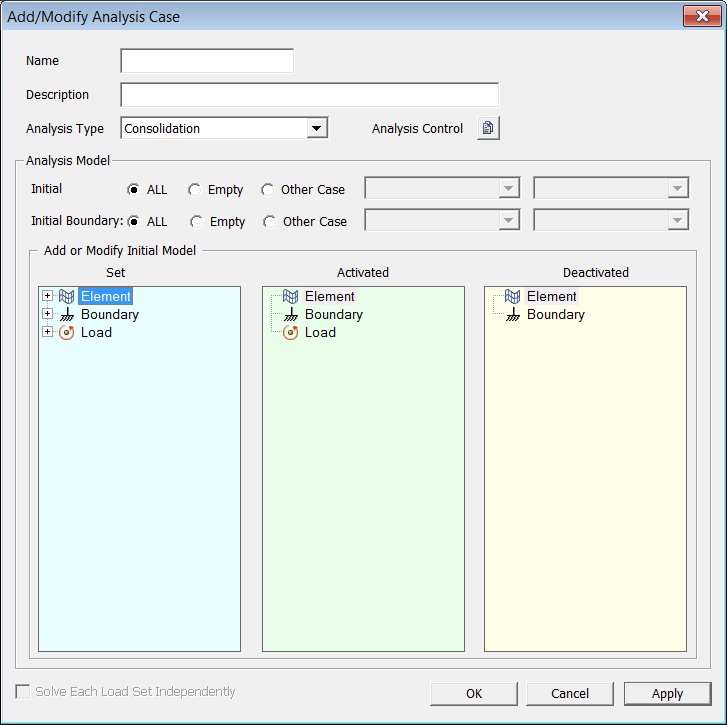
<Add/Modify Analysis Case-Consolidation>
Specify model data sets for Consolidation Analysis. The data can be activated/deactivated per set by dragging them into the appropriate menu.
Click  button
to define detail options of Analysis Control
for Consolidation Analysis.
button
to define detail options of Analysis Control
for Consolidation Analysis.
Analysis Type - Slope Stability (SRM)
Strength Reduction Method to performs slope stability analysis. In the analysis case, users can select the Analysis Model and modify the Analysis Control.
.png)
<Add/Modify Analysis Case-Slope Stability (SRM)>
Specify model data sets for Slope Stability Analysis. The data can be activated/deactivated per set by dragging them into the appropriate menu.
Click  button to define detail options of Analysis
Control for Slope Stability Analysis (SRM).
button to define detail options of Analysis
Control for Slope Stability Analysis (SRM).
Analysis Type - Slope Stability(SAM)
Perform a slope Stability analysis using Limit
Equilibrium Theory. The Analysis Model and Analysis Control can be defined.
Please see example of Slope Stability Analysis based on Stress Analysis Method.
.png)
<Add/Modify
Analysis Case-Slope Stability (SAM)>
Specify model data sets for Slope Stability Analysis. The data can be activated/deactivated per set by dragging them into the appropriate menu.
Click  button to define detail options of Analysis
Control for Slope Stability Analysis (SAM).
button to define detail options of Analysis
Control for Slope Stability Analysis (SAM).
Analysis Type - 1D/2D Equivalent Linear (Dynamic)
Go to Main menu: Tools > 1D Equivalent Linear Analysis...
Go to Main menu: File > Project Settings > Model Type > 2D Equivalent Linear Analysis...
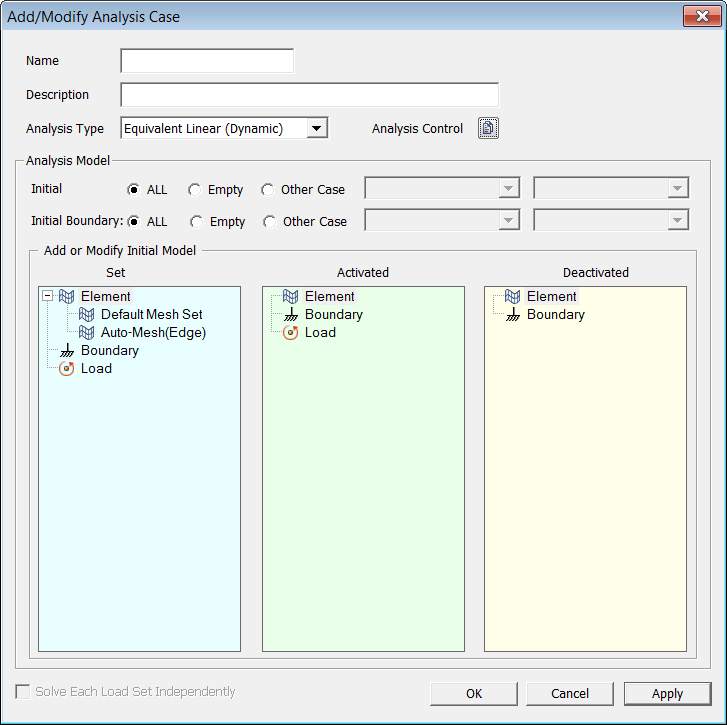
Specify model data sets for Equivalent Linear (Dynamic). The data can be activated/deactivated per set by dragging them into the appropriate menu.
Click  button to
define detail options of Analysis
Control for Equivalent Linear (Dynamic).
button to
define detail options of Analysis
Control for Equivalent Linear (Dynamic).
Stress-seepage semi-coupled analysis
In order to simulate the change in pore fluid pressure, the initial groundwater level must be modelled using nodal head boundary conditions that are applied to the corresponding mesh sets. The set data must be activated in the first "Stage Type" of type Seepage (Steady State/Transient). The pore pressure calculation from seepage analysis will then be calculated and carried over into the second "Stage Type" of type Construction and considered in the total stress results.

